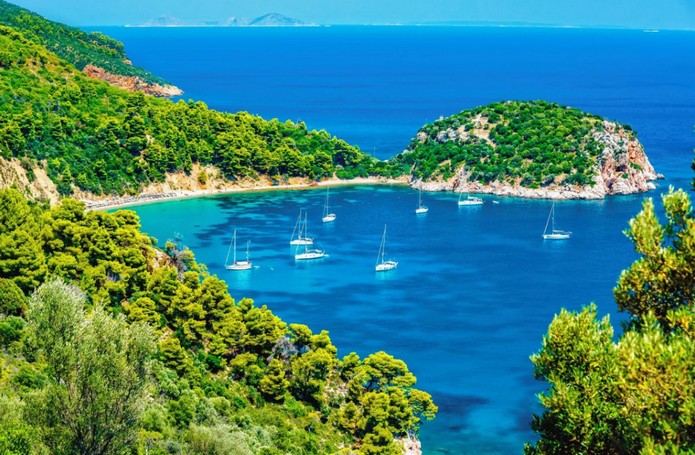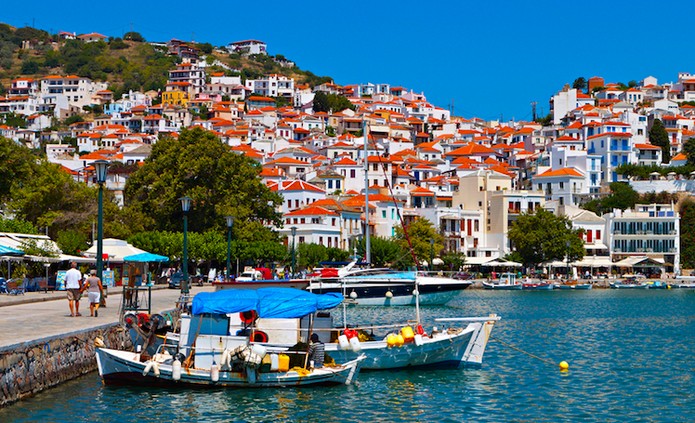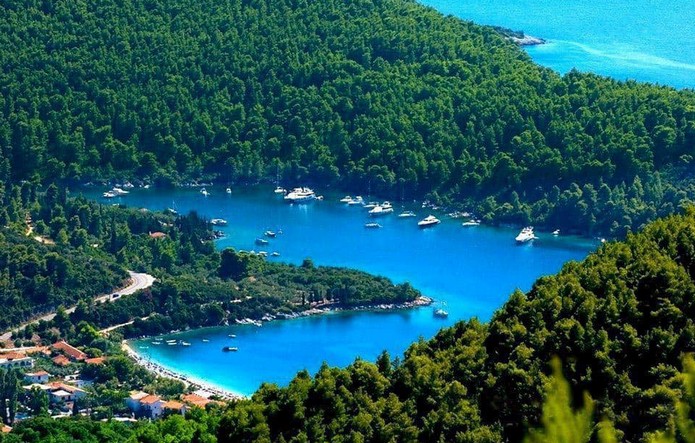Skopelos lies to the east of Skiathos of Skiathos from which it’s separated by the Skopelos channel about 8km wide. Its terrain is mountainous and the highest peak is Delphi. The larger part of the island is covered by thick pine woods and fruit trees, olives, vines etc. all grown in the remaining area.
The prunes of Skopelos are excellent. They are dried in colorful ovens and exported. The island has an area of 96 sq km and 67km of coastline. In ancient times it was called Paperethos. The earliest inhabitants were Cretans who came from Knossos under their leader Staphylos, son of Ariadne.

Skopelos was a member of the Athenian Confederacy and was later conquered by the Macedonians. In 340 BC the inhabitants of the island drove out the Macedonian garrison that had been established on the neighbouring island of Alonissos. Philip II then ordered his men to devastate Skopelos and destroy the three cities of Panormos, Selinous and Peperethos. It was renamed Skopelos in the Hellenistic period.
During Byzantine times it was used as a place of exile. Under the Franksit belonged to the Ghizi family. It was plundered by Barbarossa (1538) and became subject to the Turks. in 1630 it was annexed to the Greek state after its people had participated in the Greek War of Independence in 1821 with their fleet.
TOUR OF THE ISLAND
Skopelos, the capital, is a characteristic island town, built at the head of a sheltered bay also named Skopelos. Its traditional two and three- story houses are impressive with their balconies full of flower pots, their tiled roofs and their rich interior decoration (carved furniture, textiles, embroideries etc.).

A few defensive houses (kastrospita) with their impressive architecture are preserved in Frangomakhala (the Venetian quarter) and in the countryside there are buildings known as “kalyvia” (huts). These are two- storey farm houses in which the villagers used to stay during the harvest period. In the town itself it’s worth visiting the traditional house of the writer Pavlos NIrvanas which is now a museum exhibiting relics of the writer himself and some of the 123 churches.
Skopelos is the largest island in Sporades after Skyros. As soon as you see the white houses from the boat, the whole town clinging to the top of the hills, you want to go for a stroll along its beautiful waterfront.
From Stafylos bay you will go to the bay of Agnontas and to the idyllic Panormos with a lush green little island at its entrance. Then the famous Milia with its seemingly endless sand beach. The asphalt road will take you to Elios and then up to Glossa to end at Loutraki which is the second harbour on the island. Thus, you will have seen all the southwest coast of Skopelos and the northeast will be left with its steep ravines and rocks battered by the meltemi winds
Monasteries
There are many monasteries on Skopelos- more than a dozen built on beautiful lush green sites with remarkable churches, old icons and remarkable paintings. The main ones are:
Agios Riginos Monastery- It is about 3km south of Chora.

This is not a frequently visited monastery. Despite that, it’s of the greatest geographical and historical importance since here lies the tomb of Agios Reginos, the patron saint of the island who was martyred on Skopelos in 362. Episkopi Monastery- it is called simply Episkopi and is only 10km from Chora. It was the seat of a bishop.
Evangelistria Monastery- one of the most important monasteries on the island, about 3km east of Chora. Built in the 18th century by the Skopelitan scholar Depante. There is a fabulous carved wooden iconostasis in its main church. Metamorphosis Monastery. It is also east of Chora. Its main church is cruciform with wall paintings and an extraordinary iconostasis. Prodromos Monastery. 6km north-east of Chora. Built in the 17th century. There are important relics here too.
Skopelos or Chora
Its white house built amphitheatrically on the slopes of the hills many years ago had roots of stone slabs. The whitewashed niches on these roofs stood out like a white line and all Chora had a fairy-tale look.
Today the stone slabs have been replaced by tiles and the white niches on the ridges of the roofs are rare. Despite this change, Chora, Skopelos, continues to be one of the loveliest settlements in the Aegean. Its beauty is complemented by the rich vegetation all around it and its famous churches which number over 100.
Prominent among them are Zoodochos Pigis, Archangelos Michael, Christos and Agios Athanasios in the ruins of Castro. It’s worth to visit an old Scopelian home to see the interior arrangement of the space and the decoration which consists of weavings, embroideries and ceramics- all products of local folk art.